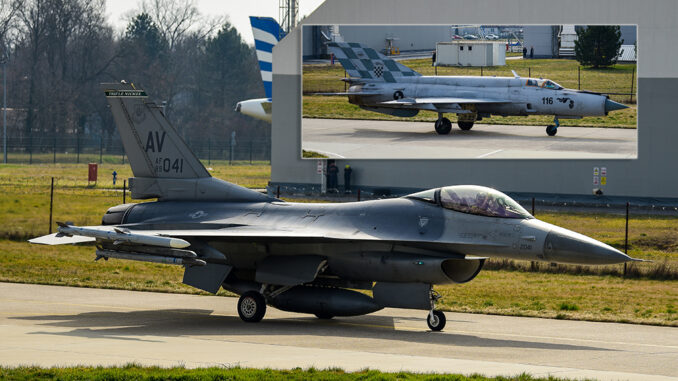Two Aviano F-16s Deployed To Croatia After Soviet-Era Drone From Ukraine Crashed In Zagreb

The U.S. Air Force F-16s from Aviano AB deployed to Croatia to operate with the local MiG-21s in the days that followed the mysterious Tu-141 drone crash.
Two F-16s belonging to the 31st Fighter Wing from Aviano Air Base, Italy, deployed to Croatia’s 91st Air Base at Pleso, from Mar. 15-17, 2022. The deployment, testing an ACE (Agile Combat Employment) operation followed the mysterious crash of a Soviet-era Tu-141 Type 2 drone in Zagreb, that flew all the way from Ukraine to Croatia before crashing in the Croatian capital at around 23: 00 local time on March 11, 2022.
The stray six-ton unmanned reconnaissance drone left a 10-feet crater after crossing the NATO airspace over Romania and Hungary: an incident with many unknown details (first of those the nation operating the drone, Ukraine or Russia?) that raised multiple questions and concern about NATO’s ability to protect Eastern Europe’s airspace. While Hungarian and Romanian officials tried to explain why they were unable to respond to the threat, Croatian authorities, who said the drone carried a 120-kg bomb, were pretty vocals criticising the sloppy response to the violation of the NATO’s airspace.
On Mar. 15, Prime Minister Andrej Plenković said in a press conference that the U.S. would send the F-16s to “give support of Croatia’s security” as two Vipers from Aviano were already on their way to Croatia’s 91st Air Base at Pleso, just outside of Zagreb.
</p>
<p> ” data-image-title=”31st Fighter Wing participate in Air Combat Employment operations with Croatian Allies” data-large-file=”https://theaviationist.com/wp-content/uploads/2022/03/Croatian-MiG-21-706×394.jpg” data-medium-file=”https://theaviationist.com/wp-content/uploads/2022/03/Croatian-MiG-21-460×257.jpg” data-orig-file=”https://theaviationist.com/wp-content/uploads/2022/03/Croatian-MiG-21.jpg” data-orig-size=”1024,572″ data-permalink=”https://theaviationist.com/2022/03/23/aviano-f16-croatia/31st-fighter-wing-participate-in-air-combat-employment-operations-with-croatian-allies/” height=”394″ src=”https://theaviationist.com/wp-content/uploads/2022/03/Croatian-MiG-21-706×394.jpg” width=”706″></img><figcaption id=) A Croatian MiG-21 pilot assigned to the 191st Fighter Squadron taxis out to the flight line during Agile Combat Employment operations with the 31st Fighter Wing, Aviano Air Base, Italy at Croatia’s 91st Air Base at Pleso, March 17, 2022. (U.S. Air Force photo by Tech. Sgt. Miquel Jordan)
A Croatian MiG-21 pilot assigned to the 191st Fighter Squadron taxis out to the flight line during Agile Combat Employment operations with the 31st Fighter Wing, Aviano Air Base, Italy at Croatia’s 91st Air Base at Pleso, March 17, 2022. (U.S. Air Force photo by Tech. Sgt. Miquel Jordan)“The 31st FW is here in Croatia to train with our NATO Allies and hone our skills to be prepared for any challenges that are presented to us,” said U.S. Air Force Capt. Russell Main, 555th Fighter Squadron F-16 Fighting Falcon pilot and ACE project officer in a public statement.
During the ACE event, two F-16Cs practiced tactical intercepts with the Croatian MiG-21BisD/UMD jets. Only 12 remaining Fishbeds with only a handful in operational conditions are operated by the Croatian Air Force. The jets are assigned to 191st Fighter Aircraft Squadron of 91st Wing of the Croatian Air Force and located in the “Pukovnik Marko Živković” Barracks near Zagreb, from where they provide QRA (Quick Reaction Alert): despite the age of its interceptors, Croatia is the only only Ally on the eastern Adriatic Sea that flies Air Policing missions with its own fighter aircraft closely integrated into the NATO Integrated Air and Missile Defence System (NATINAMDS).
“This skill can be used in a multitude of scenarios including cooperative environments or combat,” said Main. “Getting a chance to employ an F-16C against a MiG-21 presents different challenges that we’re not used to, day to day. It’s a unique opportunity to have that experience as an F-16 pilot.”
“We were informed that we would get [U.S. Air Force] support to fly with us to patrol over the [Croatian] border, to get experience with [F-16C Fighting Falcons] so we could be well prepared,” said LtCol Zvonimir Milatović, 191st Fighter Squadron commander and MiG-21 fighter pilot. “We also discussed what certain missions could [entail], so we decided to make a couple of tactical intercepts, patrolling and information flying with [basic fighter maneuvers]”
The joint training lasted only a few days as the deployment was rather symbolic and aimed at reassuring the local public opinion “of NATO’s dedication to an enduring alliance and partnership between the U.S. and Croatia.”
The Croatian Air Force will replace its obsolete Soviet-era interceptors with 12 second-hand Dassault Rafale jets as part of a government-to-government deal with France, worth 999 million euros, signed during a ceremony in Zagreb on Nov. 25, 2021. The contract reportedly involves 10 single-seater and two twin-seater Rafales in the F3-R standard, with the first six aircraft scheduled to be delivered in 2024 and the remaining ones due the following year.
David Cenciotti is a freelance journalist based in Rome, Italy. He is the Founder and Editor of “The Aviationist”, one of the world’s most famous and read military aviation blogs. Since 1996, he has written for major worldwide magazines, including Air Forces Monthly, Combat Aircraft, and many others, covering aviation, defense, war, industry, intelligence, crime and cyberwar. He has reported from the U.S., Europe, Australia and Syria, and flown several combat planes with different air forces. He is a former 2nd Lt. of the Italian Air Force, a private pilot and a graduate in Computer Engineering. He has written five books and contributed to many more ones.
Source: Two Aviano F-16s Deployed To Croatia After Soviet-Era Drone From Ukraine Crashed In Zagreb